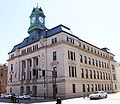.gif)
Webster County Courthouse (Iowa)
Encyclopedia

Fort Dodge, Iowa
Fort Dodge is a city and county seat of Webster County, Iowa, United States, along the Des Moines River. The population was 25,206 in the 2010 census, an increase from 25,136 in the 2000 census. Fort Dodge is a major commercial center for North Central and Northwest Iowa. It is located on U.S...
, Iowa
Iowa
Iowa is a state located in the Midwestern United States, an area often referred to as the "American Heartland". It derives its name from the Ioway people, one of the many American Indian tribes that occupied the state at the time of European exploration. Iowa was a part of the French colony of New...
, United States
United States
The United States of America is a federal constitutional republic comprising fifty states and a federal district...
. Built in 1902, it primarily houses local government offices for Webster County
Webster County, Iowa
-2010 census:The 2010 census recorded a population of 38,013 in the county, with a population density of . There were 17,035 housing units, of which 15,580 were occupied.-2000 census:...
. It has been listed on the National Register of Historic Places
National Register of Historic Places
The National Register of Historic Places is the United States government's official list of districts, sites, buildings, structures, and objects deemed worthy of preservation...
since 1981.
History
The current courthouse is Webster County's third courthouse. After the county was organized in 1852, the community of Homer was designated the county seat, and a courthouse was built there. When a controversial election resulted in the county seat being moved from Homer to Fort Dodge in 1856, local officials decided to construct a courthouse in the new county seat. Construction began in 1859 with the laying of the cornerstone, and the two-story courthouse was finished two years later; however, this courthouse soon became insufficient for the county's needs. Accordingly, the old building was destroyed and a new four-story courthouse built on the same site. This stone building represented a significant expansion of its predecessor, and it included elements such as a clock tower and more ornate. This final version of the courthouse was not completed until 1902, at which point approximately $39,450 had been expended in constructing the building. By 1980, the courthouse required extensive renovations, including a new roof, exterior repairs, restorations to the clock towerClock tower
A clock tower is a tower specifically built with one or more clock faces. Clock towers can be either freestanding or part of a church or municipal building such as a town hall. Some clock towers are not true clock towers having had their clock faces added to an already existing building...
, and a refurbished interior; the entire process took several million dollars and over twenty years to complete.
Present status
Today, the courthouse is the site of much local and regional government business, including the office of the county assessorAssessor (property)
An assessor is a specialist who calculates the value of property. The value calculated by the assessor is then used as the basis for determining the amounts to be paid or assessed for tax or insurance purposes....
, the meeting area for the Webster County Board of Health, service offices for the hearing impaired
Hearing impairment
-Definition:Deafness is the inability for the ear to interpret certain or all frequencies of sound.-Environmental Situations:Deafness can be caused by environmental situations such as noise, trauma, or other ear defections...
, and offices for the state courts of the Second Judicial District. Its architectural status led to it being listed, along with several other Iowa courthouses, on the National Register of Historic Places
National Register of Historic Places
The National Register of Historic Places is the United States government's official list of districts, sites, buildings, structures, and objects deemed worthy of preservation...
in 1981.

